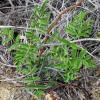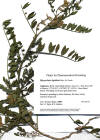|
Glycyrrhiza lepidota Kern Co., CA. Caliente Region: Walker Basin area along Rancheria
Creek. May 2015 |
Glycyrrhiza lepidota Inyo Co., CA |
|
Trees and Shrubs of Kern County (May 2015) Glycyrhizza. (sweet root). Rhizomatous herbs, sometimes appearing shrubby by the old persistent leafless brown to gray stems; leaves with impressed glands or the glands at tips of hairs; stipulate, leaves in our species pinnate with odd terminal leaflet; flowers typically pea-like, white with tinge of purple, or yellow, or blue or dull purplish, wings adherent to keel; fruit indehiscent. ~17 species, Mediterranean and temperate climates of North America, Eurasia, Australia, South America.. Licorice extracted from boiling of root-rhizomes of G. glabra, used as confectionery, and in flavoring, curing tobacco, and for treating coughs. Species in North America invasive. Glycyrhizza.lepidota Pursh 1813. Wild licorice. Aromatic herb with woody rhizomes, from which erect stems arise up to 1.2 m, sparingly branched; leaves alternate, pinnately compound with 4–9 pairs of leaflets plus one odd terminal leaflet (odd pinnate), short hairy and punctate-glandular, especially on lower surface, sometimes with stalked glands; stipules small, deciduous; leaflets, 1–4 cm long, short and acutely tapered to a pointed apex; flowers May–Jul, clustered terminally on a leaf-axillary peduncle, 2–10 cm long, the flower clusters (racemes) shorter in length than the naked part of the peduncle, off white with or without faint tiny purplish streaks or spots, or greenish white, or yellow; calyx tube 3–4 mm long; sepals 2–4 mm long; banner erect, 9–12 mm long, keel 7–11 mm long; stamens 9 united and 1 separate. Fruit an ellipsoid camara (indehiscent), 1–2 cm, bristly, the bristles hooked near tips; seeds numerous. Roadsides, along ditches, stream banks, lake shores, and seasonally flooded fields, especially alkaline soils, below 2,500 m, distributed over much of the U.S. southern Canada, extending well into Mexico. Type from the “Banks of Lewis's [Snake] River”). Kern Co.: “Scarce at wet places in the Temblor Range, possibly introduced here by the pioneers as a medicinal herb”, also Greenhorn Mts., Eastern Sierra Nevada in Grapevine Canyon; El Paso Mts., Walker Basin in the Caliente Mountains (John Beard's Ranch), and Bakersfield, 122–1220 m (CCH).. Records in CCH also list var. glutinosa (G. glutinosa Nuttall 1838) S. Watson 1876 from Erskine Creek in the Piute Mountains, and Kern Island Road, just south of the Kern Valley Packing Plant; the variety may be distinguished by the bristles extending to the pedicel. Plants with hairless pods are called G. glabra Linnaeus 1753, reported by Twisselmann to occur at Goose Lake, but no specimens in CCH for Kern County. Roots used by native Americans for treating sore throat, chest pains, swellings, coughs, diarrhea, earaches, toothaches, and also used as a febrifuge and cathartic (Moerman). NCI screening of 39 extracts in the genus found WA activity (Feb 1968) in G. echinata from an aqueous ethanol extract of the aerial parts collected in "Yugoslavia", SA activity in a methanol extract of fruit of G. glabra, and P-388 leukemia activity from leaf of G. lepidota collected July 1973 in Illinois.
|
|


